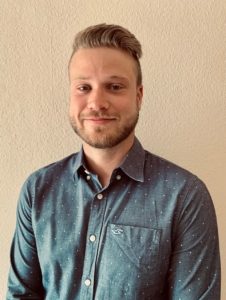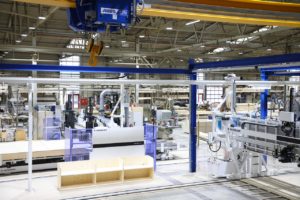More structure, more output
At the prefabricated house producer Bien-Zenker, the carpentry shop was rebuilt and modernised. The decisive role that MES can play in such a diversified production line and the benefits that result from it for the entire production process are explained by the Head of Strategic Development, Markus Farnung.
 Bien-Zenker GmbH, based in Schlüchtern, Hesse, produces and sells prefabricated houses. The company was founded as early as 1906 and is thus one of the most traditional prefabricated house manufacturers in Germany.
Bien-Zenker GmbH, based in Schlüchtern, Hesse, produces and sells prefabricated houses. The company was founded as early as 1906 and is thus one of the most traditional prefabricated house manufacturers in Germany.
The holding company distributes the two product groups “Bien-Zenker Das Haus” (turnkey houses in the medium to upper price segment) and, for rather younger target groups, “Living House” (prefabricated houses).
In 2022, Bien-Zenker GmbH produced around 990 houses in three-shift operation – in the current year 2023, the company aims to break the 990 mark.
MES also in the carpentry shop
Between 2020 and 2022, the company’s carpentry shop was completely modernised: New joinery systems, special lines, ceiling lines and roof lines.
Exciting: Manufacturing Execution Systems (MES) from granIT are now also (or especially?) being used in this technically demanding production area.
Markus Farnung (27), Head of Strategic Development/Maintenance (machines, buildings) at Bien Zenker GmbH and thus responsible for the future of the company, explains in an interview what advantages the MES powered by granIT generate in the new production line.
MES – the logical way
granIT: Mr. Farnung, in a traditional company like Bien-Zenker GmbH, it is elementary that a continuous development process takes place. Would you briefly describe when and how your company “came” to use MES?
Markus Farnung: We had already been running the granIT MES system including the Multiwall Builder software in wall production for several years. When it was decided to modernise the carpentry shop, we first found out which systems and machines were suitable for us. When we finally had our new layout, we contacted granIT right away.
Elementary support
granIT: So you decided to use MES for the new production area in the carpentry shop because of the good experience you had with MES in wall production?
Markus Farnung: The MES really helps us a lot in the wall production line! It saves time, optimises table allocation, makes our output more precise and thus supports us fundamentally in production. So it was clear to us that we also wanted to have these advantages in the carpentry shop.
granIT: Would you please tell us briefly where you use MES from granIT?
Markus Farnung: First of all, at the “normal” points, i.e. at the WEINMANN machines, where granIT MES is already running. So every table is mapped in the MES, the machines supply data and in principle there are actually only very few gaps that we close by hand scanner.
What I personally really liked: granIT immediately implemented the proposal to integrate the “Hundegger” joinery system. I know from other industrial sectors that integrating a machine that does not come from the “familiar” MES environment can be difficult.
For granIT, this was not a problem: Shortly afterwards, they supplied us with an interface to the “Hundegger” system, which now makes the interaction of all the machines much easier.
So now we have the joinery machine as a start in the carpentry shop. As soon as the job is finished with the joinery, Hundegger transfers all the relevant information to a cloud, where the MES receives it and processes it further.
The bottom line is that we have significantly optimised our production. For example, we additionally want to integrate all manual workstations with, among others, beam and rafter preparation.
Production significantly optimised
 granIT: So the production process has become more fluid and transparent thanks to MES.
granIT: So the production process has become more fluid and transparent thanks to MES.
Markus Farnung: But it goes even further. We use MES not only in production, but also towards the end of the process during loading. In short, with the use of MES we hoped for a fluid and effective flow from the beginning to the end of the production process. Which is indeed the case in our company now.
granIT: Now the decision to use MES and its successful installation depends on many factors. Were there also “points” in the decision-making phase where you, as the responsible division manager, had your reservations?
Markus Farnung: At the beginning I was sceptical whether the connection to the existing system by means of MES could work at all. Especially with large production lines – also in other areas of industry – you used to hear about incompatibility again and again.
Even or especially when it comes to machines from different manufacturers.
But granIT immediately put things at ease and drew from a wealth of experience. In any case, everything ran “silently” in the sense of smoothly. For example, the wall production department didn’t even notice the changeover when it was connected to the new carpentry shop thanks to MES.
Everything went according to plan
granIT: No downtimes?
Markus Farnung: No, not really. We quietly started up the carpentry without affecting the other production areas. But – one time there was a problem: the data was not recorded completely. A quick call to granIT and the matter was settled ten minutes later and has been working perfectly ever since.
In this context, I must emphasise that granIT’s flexibility plays an elementary role, especially when setting up new production lines.
Imagine that someone wants to rotate an element or that it should rotate automatically or that the lengths on the blank should be adjusted. No matter what, once the service contract has been concluded with granIT, the responsible employee can be contacted and the implementation takes place as soon as possible.
More structure, more output
granIT: Let’s move on to the benefits of MES. Where has the Manufacturing Execution System proved particularly useful at Bien-Zenker GmbH?
Markus Farnung: I have to “split” thematically. In wall production, the MES clearly results in more output, and in the new carpentry shop, the MES has above all brought structure – which ultimately also leads to more output.
In the carpentry shop, one programme now dictates the entire production sequence. Transparency for everyone involved in production and administration has improved enormously. Everyone knows at a glance in the computer which part is currently being produced where and how.
granIT: Mr. Farnung, we would like to thank you for the insight into the production process at Bien-Zenker and wish you continued success with and in your new carpentry shop!

